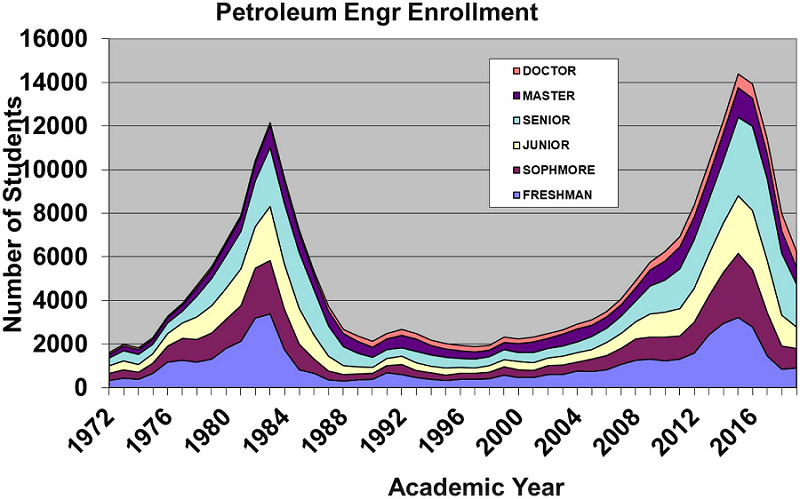After a record-high 2,550 bachelor of science (BS) degrees awarded in petroleum engineering in 2017, the number of students earning bachelor’s degrees is expected to drop sharply over the next few years, according to a new study.
That number is projected to drop to less than one-sixth of the 2017 number—to only 400—by 2022 and remain in the 200–400 degrees-per-year range for the next 10 years, according to research conducted by Texas Tech University Professor Lloyd Heinze, who annual tracks enrollment figures. He presented his findings at the recent 2019 SPE Annual Technical Conference and Exhibition in Calgary. Degrees granted are projected to drop to 980 in 2020.
In addition to projections about the declining number of degrees, Heinze and his coauthors of a paper on petroleum engineering enrollment drew the following conclusions.
Petroleum engineering enrollment and the resulting degrees granted are greatly affected by oil and gas prices, and the changes lag prices by 2.5 years.
The pipeline to produce new engineers is 4 to 5 years long.
As industry petroleum engineering requirements increase, it will take several years to increase the supply from previous conventional sources (programs/universities).
Heinze has polled university petroleum engineering department heads each September since 1992 to collect information on enrollment and degrees conferred and mad it available to the programs and others expressing an interest. The surveys are based on September-to-May/June academic years. While the survey includes primarily US universities, it has expanded to include information over the past 5 years from non-US programs as well.
Survey Highlights
Highlights of the study, contained in SPE 195908, are:
Between 1956 and 2019, three petroleum engineering BS peak years occurred: 779 in 1958, 1,529 in 1983, and 2,550 in 2017.
Four petroleum engineering programs were accredited by the Accreditation Board of Engineering and Technology in its inaugural accreditation year of 1936: Louisiana State University (LSU), Oklahoma University (OU), The University of Texas, and Texas A&M University. All four remain in the top 10 US schools in terms of enrollment, but Colorado School of Mines and the University of Houston have overtaken LSU and OU in the top four.
The number of US college and university campuses offering petroleum engineering has dropped from 35 to 20.
Non-US petroleum engineering programs have increased since 2016. In 2019, there were 11 non-US and 20 US-based accredited petroleum engineering programs.
While freshman and sophomore enrollments drop quickly with a down job market and respond rapidly to an uptick in the job market, junior and especially senior enrollments respond more slowly. This is most likely a result of time invested toward a degree.


